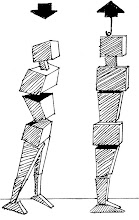Strategy Zero: Defensive Care
This is the path of least resistance. This is basically a “fix it when it’s broke” mentality. Our medical system supports this way of thinking, and unfortunately we pay a premium for broken bodies in both time and finances. This strategy falls short on several fronts such as when:
1. your doctor says “it ain’t broke” when you know it is… then you’re up a creek.
2. after looking over expensive diagnostic test results your doctor admits it’s broke, but we don’t know how to fix it
3. your doctor says we can fix it but here’s the list of complications and awful side effects my “fix” will create.
Unfortunately, this puts you at the mercy of doctors and the medical system, albeit good, it’s a limited strategy that can yield poor results, and operates with a high risk/side effect margin.
I think when you factor in quality of life to your decision making process, you have to do more. You must change from the typical defensive healthcare model into an offensive or strategic position with your health. The good news is I believe we have an innate ability to know when something is amiss and get care before it’s too far developed, as well as utilize common healthy practices, and preventive measures to maintain health for the long run.
Strategy One: Fight the Losing Battle
When an MD can’t fix it then go to preventive care and/or make a change in diet/exercise/etc.. While this is a decent strategy, and one many people use, this strategy is just an add-on to “strategy zero”. It fails to address chronic problems prior to their entrenchment. Type 2 Diabetes, carpal tunnel, and obesity are all examples of problems that take years to develop. The conundrum of “you don’t know what will kill you till it’s a too late” is the threat here and unfortunately this strategy can lead to mediocre results.
Though a few “home runs” are always the exception to this rule the danger here is that fundamentally a long-term issue is not be properly addressed. Short-term solutions are just that. Living well works best in a proactive format. Asking too much out of a regimen renders suboptimal results, and the tides of the health battle may turn for a day, a week, several months, then strategy zero takes over again and you’re back to where you started. That said, it’s never too late to quit smoking!
Strategy Two: The Adherent
Exercise, eat right, get 8 hours of sleep. This is the mantra of “healthy living” for our culture. If you have an excellent primary care doctor she will remind you to do these things when you visit her office. Additional common recommendations are: maintain a healthy BMI (weight to height ratio), maintain positive social interactions/ friendships, quit smoking, and don’t abuse alcohol or other drugs. This is all standard preventive care and in general I think it should be followed. If you work for a company that has “wellness” programs in place these are generally the types of behaviors it will assess and suggest.
I applaud you if you’re on this track right now. Keep it up, but remember the middle road as well. Fitness and diet are just as crucial as relaxation and good social interaction. The trap for the Type-A is to turn this approach into a do or die strategy, which can turn into another job on top of the already high-powered career you have. Remember the middle road.
Strategy Three: Proactive Ignorance
This preventive strategy guides you to seek to build awareness and change/expand your internal health indicator. This may be the heart of preventive care in that the devotee asserts, “I don’t know what I don’t know so I need help finding it”. A strategy that seeks out and catches the beginning stages of illness in its path and redirects the body towards health is the optimal lifestyle choice. During massage and Rolfing sessions, people are amazed to realize the amount of tension they carry in their body. When someone begins meditation he may be startled at the amount of constant internal chatter inside his head. When someone begins exercising she may be enlightened by the newfound amount of energy she has after a workout – when previously she had just felt too drained to workout. The body is a miracle, and we must approach it with humility and an openness to new, healthy, lifestyle changes, health practices, etc.
To some degree every person reading this probably feels justified in his/her own health choice. I hope this article has caused you to begin to think differently about your own approach towards health on a daily basis, and CityRolfer looks forward to being a part of the preventive care plan for your own body. Resilience: Managing Your Energy
by Greg Brynelson




